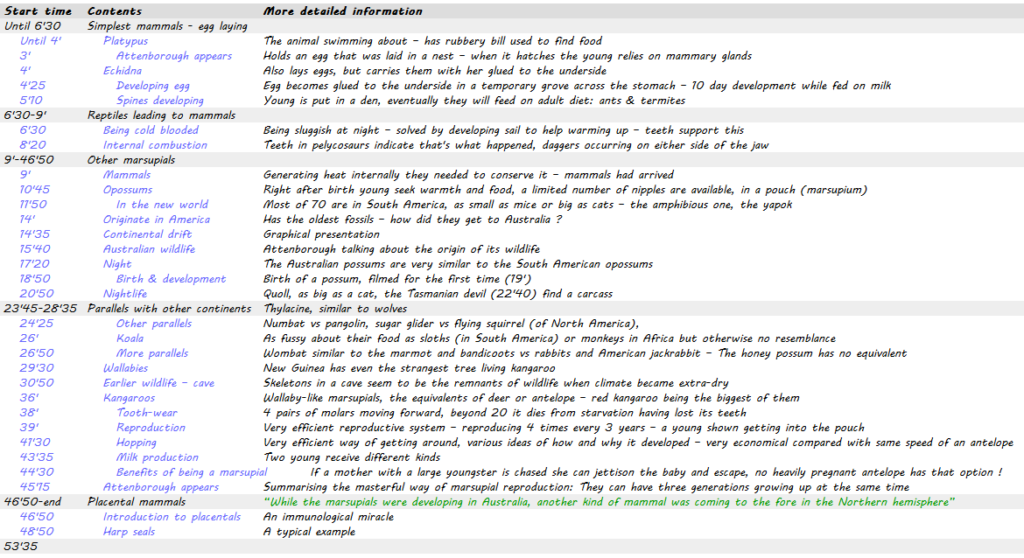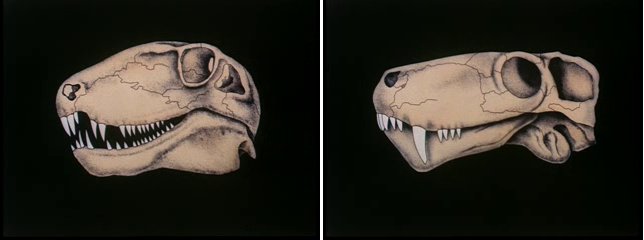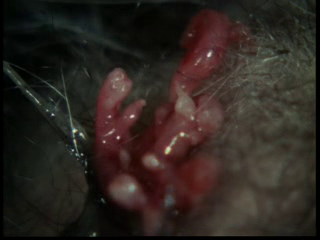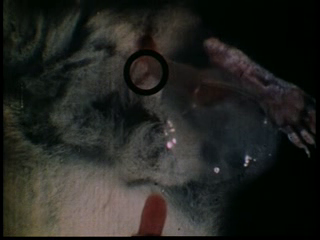Original air date: 13 March 1979
This episode is actually an introduction to the rest of the series covering the mammals, this one deals with the early mammals ending with an introduction to placental mammals as shown in the image below.

As the outline above indicates even though the episode deals almost only with the earliest mammals there are many different ways to deal with them, like a simple comparison with other continents due to continental shifts. A more detailed timeline is below

Selected material:
Talking about the heat regulation among dinosaurs (7’15) and turning his head as if he was actually looking at the animal, not just at a point where the image would be placed later on.

It is not too hard to see he would only looking at the animal’s belly, if the animal was there in the first place.
Dinosaurs becoming warm blooded ? (8′-8’20)

A dimetrodon with normal teeth (left) developing into a pelycosaur (with daggerlike teeth)
The possum in the Australia that is filmed with young, a sequence that might be a television first (10’45).

Their birth was filmed specifically for the series (19’35)

In the final scene describing a seal developing within the mother and how antibodies are working it doesn’t take much scrutinising to notice that even though it is composed of numerous separate parts they all constitute to one whole entity.
Coming up (Placental mammals, an immunological miracle):
“Retaining the baby within the womb until it’s fully formed seems an obvious way for the mammals to improve the care of their young. But in fact it causes considerable problems in body chemistry. For one thing, the tissues of this little pup differ in a genetic way from those of its mother. They contain elements from the father. And so that means that it risks, when it’s within the womb, rejection by the mother’s body, just as a transplant does.
Secondly, the young in the womb may be ejected if the mother produces another egg and comes on heat again. That problem doesn’t face a baby marsupial, for in every case its short development takes place within the period of the mother’s sexual cycle. But a placental mammal, like this seal, has a much longer development, and it deals with the problem by producing, from within the placenta, a substance which actually suspends the mother’s egg production. It manufactures other biochemical substances which suppress production of the antibodies that cause the rejection of tissue, and so allows the developing young in the womb to remain there. So the placenta has had to become a chemical factory of great complexity. When the young is finally born, the placenta, too, is shed from the womb as the afterbirth. The body of a mammal, whether it’s our own or a seal’s, is extremely complex and takes a very long time to fully develop. These young seal pups around me were conceived almost a year ago, and, until a few days ago, were kept in the warmth and safety of their mother’s body as she swam through the freezing polar seas.
No marsupial could be reared in such a way because marsupial babies in the pouch need to breathe air. In fact, the placenta and the womb between them provide a degree of safety and a continuity of sustenance which is unparalleled in the animal world. And together they form one of the keys to the success of the placental mammals, which have, in the end, colonised all parts of the world, including even these bleak, inhospitable ice flows.”
Attenborough comes back on screen and from now on his on-screen voice is heard even when he is actually off-screen. The obvious question is why it is all so scrambled. Is it deliberate? Did they just decide to play with technology or did a part of the actual recording on location fail and they have to repeat it in studio?
Filming locations:
If the episode had been only about the currently living marsupials its filming locations would have been restricted to Australia and its neighbouring islands, but following their evolution changes this as well as the continuation into placental ones in Africa and somewhere in the arctic.
Attenborough shows up with an egg of a platypus (3’30) in Australia
and later with the echidna (5’50)
Talking about the origin of marsupials in Patagonia (14′)
Showing harp seals in the Arctic (49′)